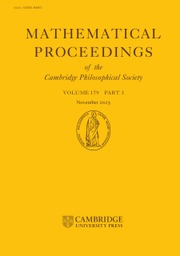Article contents
The factorisation property of l∞(Xk)
Published online by Cambridge University Press: 10 December 2020
Abstract
In this paper we consider the following problem: let Xk, be a Banach space with a normalised basis (e(k, j))j, whose biorthogonals are denoted by  ${(e_{(k,j)}^*)_j}$, for
${(e_{(k,j)}^*)_j}$, for  $k\in\N$, let
$k\in\N$, let  $Z=\ell^\infty(X_k:k\kin\N)$ be their l∞-sum, and let
$Z=\ell^\infty(X_k:k\kin\N)$ be their l∞-sum, and let  $T:Z\to Z$ be a bounded linear operator with a large diagonal, i.e.,
$T:Z\to Z$ be a bounded linear operator with a large diagonal, i.e., $$\begin{align*}\inf_{k,j} \big|e^*_{(k,j)}(T(e_{(k,j)})\big|>0.\end{align*}$$
$$\begin{align*}\inf_{k,j} \big|e^*_{(k,j)}(T(e_{(k,j)})\big|>0.\end{align*}$$
Information
- Type
- Research Article
- Information
- Mathematical Proceedings of the Cambridge Philosophical Society , Volume 171 , Issue 2 , September 2021 , pp. 421 - 448
- Creative Commons
- This is an Open Access article, distributed under the terms of the Creative Commons Attribution licence (http://creativecommons.org/licenses/by/4.0/), which permits unrestricted re-use, distribution, and reproduction in any medium, provided the original work is properly cited.
- Copyright
- © Cambridge Philosophical Society 2020
Footnotes
Supported by the Austrian Science Foundation (FWF) under Grant Number Pr.Nr. P28352, P32728 and by the 2019 workshop in Analysis and Probability at Texas A&M University.
Supported by the National Science Foundation under Grant Number DMS-1912897.
Supported by the Austrian Science Foundation (FWF) under Grant Number Pr.Nr. P28352 and by the 2019 workshop in Analysis and Probability at Texas A&M University.
Supported by the National Science Foundation under Grant Numbers DMS-1464713 and DMS-1711076.
References
REFERENCES
- 3
- Cited by

